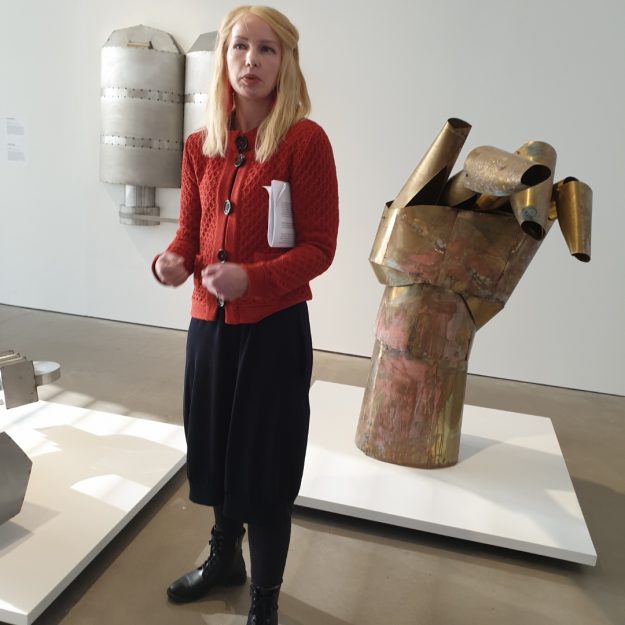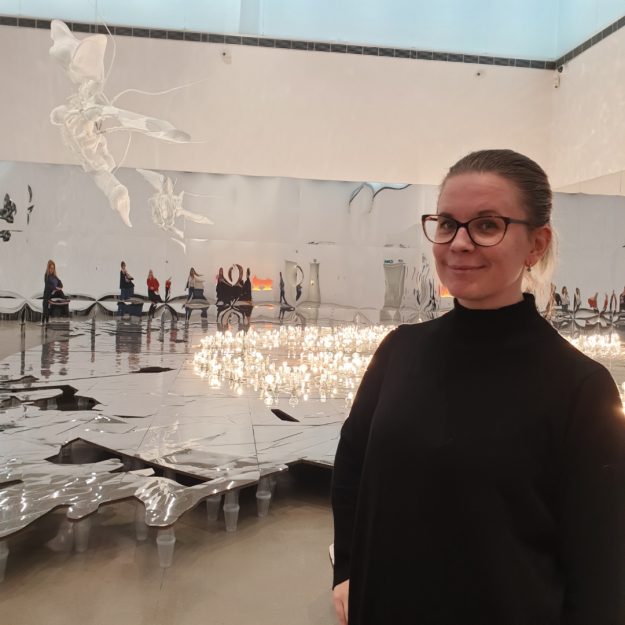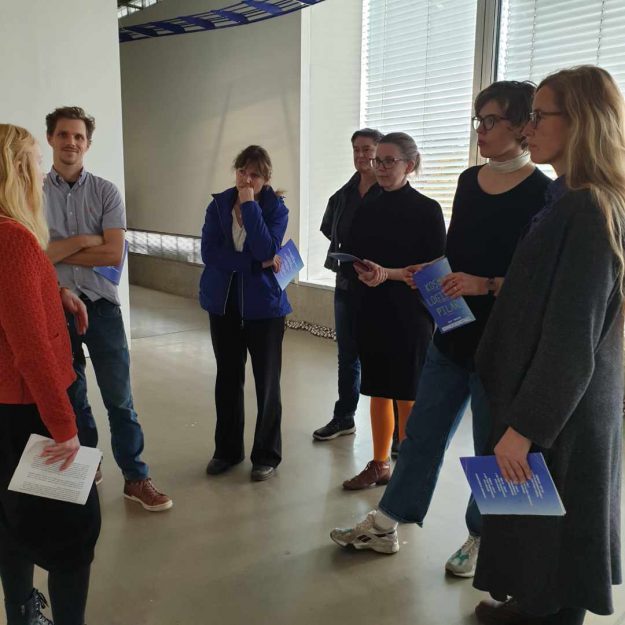by Caroline Elgh Klingborg, Curator, Bonniers Konsthall
Last fall, I brought a group of researchers and guests from KTH’s Division of History of Science, Technology, and Environment to the exhibit I curated for Bonniers Konsthall, entitled Cosmological Arrows: Journeys through Inner and Outer Space.* Their curiosity in the powers of science fiction and speculative fiction by way of research and teaching (for instance, the course Science Goes Fiction) sparked engagement and conversation, for which I’ve been asked to contribute my thoughts behind the exhibit. As I see it, we are living in a world where we are facing countless ecological, technical, and political challenges. The state of the world is an apparent and important part of the public debate where researchers, activists and other engaged people want to create visibility and change. At the same time, there also seem to be a growing sense of powerlessness, especially among young people, that it might be too late to save our planet. Since we are facing all these challenges together as humans and more-than-humans living on this damaged planet, we need new forms of interdisciplinary knowledge and new forms of collaborations. And here we can turn to the arts.
During recent years, we have seen a growing number of exhibitions and art projects—internationally and in Sweden—that evolve around the state of the world and our present future. Nearby subject areas such as science fiction, space, co-habitation and the more-than-human have interested an increasing number of artists in recent years. Themes like these have been featured in international exhibitions such as Gravity: Imagining the Universe after Einstein at MAXXI in Rome, Is This Tomorrow? at Whitechapel Gallery in London, Tomorrow is the Question at ARoS in Århus, and—not least—May You Live in Interesting Times curated by Ralph Rugoff for the latest Venice Biennale. In Sweden, I need to point at exhibitions such as The non-human Animal at Uppsala Art Museum, Sensing Nature from Within at Moderna Museet in Malmö and Animalesque and Art Across Species and Beings at Bildmuseet in Umeå. It is distinctly clear that visual artists, curators and art institutions feel the need to engage with the rapid technological, ecological and political changes the world is going through—and to rethink the definitions of nature, agency, materiality and what it means to be human.

Climate researchers like Keri Facer has spoken about the arts as something we will need more of in the present future and that art can teach us about experimental thinking and how to live with some uncertainty. So, from various disciplines, there seem to be an openness and wish for interdisciplinary collaborations to bring forward new perspectives on human and more-than-human forms of co-habitation. Some of these perspectives were brought forward in the exhibition. The exhibition was shown during autumn 2019 and assembled a group of artists—Allora & Calzadilla, Lee Bul, Agnieszka Brzeżańska, Debora Elgeholm, Johannes Heldén, Anna Hoetjes, Jone Kvie, Lawrence Lek, Caroline Mesquita, Brittany Nelson, Lea Porsager, Larissa Sansour, Arseny Zhilyaev and Asya Volodina—who are all interested in science fiction and humanity’s conception of the cosmos. In keeping with our own time, my intention for this exhibition was to highlight how visual artists are using space and the genre of science fiction as an imaginary laboratory that forms the basis for discussions of today’s ethical, moral, existential and political dilemmas.

Cosmological Arrows showed the connections between contemporary art and science fiction, and how this rather new relationship can contribute to new ways of thinking, being and acting in the world. In the preface to her science fiction novel The Left Hand of Darkness, Ursula K. Le Guin (1929–2018) writes about how she uses science fiction to do leaps of imagination. Le Guin does not believe that her work as an author contributes any kind of evidence-based research into how the future will look (because no divine or visionary prophesies come from science fiction) but instead describes reality and the time in which the book is being written.
This reading was also appropriate for the artworks presented in Cosmological Arrows. The exhibition clearly showed that science fiction does not constitute an escape into another world. Rather the exhibition highlighted and illustrated an intricate interplay between reality and fiction in which science fiction became a tool for testing and conceiving of various historical, contemporary or future scenarios. Even if the works presented were (rather dystopian) portraits of our time—and dealt with our reality on the only planet that is habitable (as far as we know today)—the conceptual worlds that the artists can create with the help of science fiction could perhaps offer us a certain understanding of or preparation for what might await us in the future.

I am sure we will see more of these perspectives and initiatives within the arts during upcoming years. The genre of science fiction has gained new relevance today and its themes and images bring together artists, film makers, writers and academics—bridging the gap between art, popular culture, activism and academia.
*The exhibition was accompanied by a publication with the same name. The book contains texts by Caroline Elgh Klingborg, Jerry Määttä, Mahan Moalemi, and Cecilia Åsberg, as well as short stories by Aleksandr Bogdanov, Ted Chiang, Karin Tidbeck and Alice B. Sheldon/James Tiptree Jr. and artworks by Agnieszka Brzezanska, Allora & Calzadilla, Anna Hoetjes, Arseny Zhilyaev & Asya Volodina, Brittany Nelson, Caroline Mesquita, Debora Elgeholm, Johannes Heldén, Jone Kvie, Larissa Sansour, Lawrence Lek, Lea Porsager, and Lee Bul.
Author Bio: Caroline Elgh Klingborg is a curator of contemporary art. Her work explores interdisciplinary processes and collaborations across different fields of research. In exhibitions and publications, she has brought forward the meeting between visual arts and fields such as speculative fiction, environment, new materialisms and truth. As a curator at Bonniers Konsthall in Stockholm she has recently curated the group exhibition Cosmological Arrows. Journeys Through Inner and Outer Space and Dora Garcia´s solo exhibition I Always Tell the Truth. Caroline Elgh Klingborg collaborates with The Posthumanities Hub and is also a guest lecturer at Stockholm University´s Curating Program.

